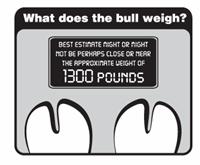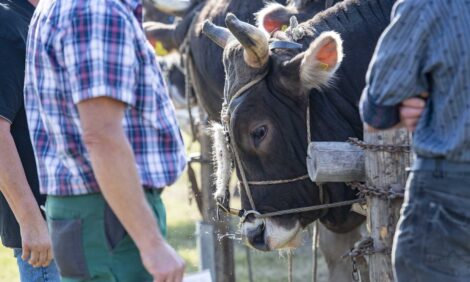



Bull Buying Basics – The Numbers Are Real, But Not Absolute
By Kris Ringwall, Beef Specialist, North Dakota State University Extension Service. When buying bulls, the actual weight of the bull is not as important as the progeny weight.In bull buying, the accuracy of expected progeny difference (EPD) is important. However, just because something cannot be measured precisely does not mean that the estimate of the value is not accurate.
Recently, my weight on a reliable scale was 172 pounds. On that same gym scale, I have weighed up to 178 pounds and as low as 171 pounds, plus all the numbers in between.

Is the scale in error? What is my real weight? Should I just pick a weight?
The correct rationale is to discover the reason for the variation. In my case, the weight relates closely to the outside temperature and type of clothing I am wearing as I leave the gym. It’s amazing how much a sweater can weigh.
I still have not answered the question that I set out to answer: What do I really weigh? The number I have is an estimate of what I truly weigh, but is not my actual weight.
My actual weight would need to be obtained in a manner not fitting for public display. Even if I weighed myself that way, the weight still would vary during the course of a few days. So, I am quite comfortable with obtaining an estimate of my weight based on a practical and consistent process, which in this case is the gym scale.
Likewise, when we buy bulls, the numbers that we print will vary. The reason for that may not be much different than the reason my weight varies. Bulls will adjust to the weather. Some days they eat a lot and other days they may not eat much at all.
If one day the bulls eat 1.5 percent of their body weight and the next day they eat 2.5 percent of their body weight, the actual weight would be off by 13 pounds on a 1,300-pound bull. If the bull was shrunk one day due to handling and shipping, the weight could vary by 6 percent (78 pounds).
The real weight is a practical and consistent estimate, which is a fairly reasonable approach. When buying bulls, the actual weight of the bull is not as important as the progeny weight.
In determining progeny weight, we first must appreciate that any time we use a number to indicate a trait, the number is an estimate. Because the number is an estimate, there is a process in the world of numbers used to indicate to what degree we are comfortable with the accuracy of the number.
That process in the world of bull selection is called just that - accuracy. The accuracy number printed alongside an EPD number is important to know.
At the gym, my weight totals could have an accuracy number printed with them. The summer and winter weights would be more consistent than spring and fall weights because the weights are more dependent on what clothes I wear. Temperatures vary more in the spring and fall than in winter or summer, so what I wear varies more.
How much do I really weigh? The estimate of my weight could be obtained simply by summing the actual weights and then dividing by the total number of weights taken. I then would have an average weight.
But again, my actual weight would not be known, only an estimate of my actual weight determined by a predefined process. Well, I know I have everyone confused. If nothing else, remember that the numbers are utilized to make sense of things we would like to know.
Unfortunately, the numbers seldom are absolute. The numbers only are estimates of what we want to talk about. The only point I want to make is that in the next column, I want to talk about the accuracy of those numbers when we use them to predict progeny differences among bulls.
For now, appreciate your headache and learn more next time.
May you find all your ear tags.
March 2008


